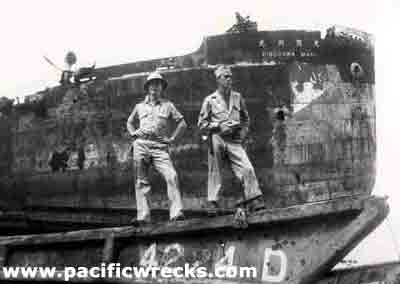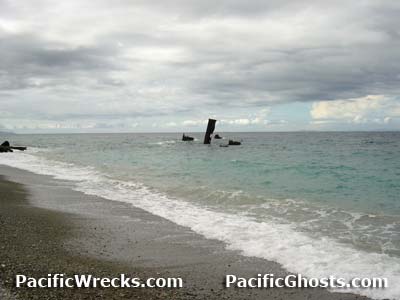|
|
|
| Missing In Action (MIA) | Prisoners Of War (POW) | Unexploded Ordnance (UXO) |
| Chronology | Locations | Aircraft | Ships | Submit Info | How You Can Help | Donate |
|
| IJA Cargo 6,937 Tons 436' x 58' 5" x 32' 8"  USN November 15, 1942  USN November 1943  George Lee Peters 1944  Robert Porter 1944  July 19, 1957  Jeff Johnson 1998  Justin Taylan 2003 |
Ship History Built by Mitsubishi Jukogyo K.K. at Nagasaki. Laid down 1938 as a 6,937 ton cargo vessel. Launched as Kinugawa Maru and registered in Tokyo. During 1939 listed as a 6,811 ton vessel. During 1940 being listed as 6,937 tons (as built). Wartime History During 1941, requisitioned by the Imperial Japanese Army (IJA) for conversion into an armed transport with 75mm Type 88 anti-aircraft guns as defensive armament on the bow. Wartime History On May 9, 1942 part of "Convoy 206" including Shinsei Maru, Tatsuwa Maru, Tatsuharu Maru, Senzan Maru, Nanyo Maru, Keifuku Maru, Taisho Maru, Meiyu Maru, Wayo Maru and Kinugawa Maru. Escorted by Tsubame and destroyer Sanae. In early November 1942 assigned to the second assault convoy under the command of Rear Admiral Raizo Tanaka that included 23 ships (11 transports escorted by 12 destroyers) to land reinforcements and supplies on Guadalcanal. The transports have embarked the Japanese Army 38th Division soldiers, Japanese Navy Special Naval Landing Force (SNLF) personnel plus equipment and provisions. The transports are divided into two groups: No. 1 Butai: Hirokawa Maru, Nagara Maru, Sado Maru, Canberra Maru and Nako Maru is scheduled to unload at Tassafaronga. The No. 2 Butai: Brisbane Maru, Shinanogawa Maru, Arizona Maru, Kinugawa Maru, Yamaura Maru and Yamatsuki Maru is scheduled to unload at Argulio Point on Cape Esperance. The transports are escorted by 12 destroyers: Hayashio (flagship of Rear Admiral Raizo Tanaka), Amagiri, Kagero, Kawakaze, Makinami, Mochizuki, Naganami, Oyashio, Suzukaze, Takanami and Umikaze. On November 12, 1942 in the afternoon departs Shortland Harbor then proceeded southeast down "The Slot" bound for Guadalcanal. The convoy was scheduled to arrive on November 13, 1942 in the early morning but were recalled Shortland Harbor due to the first phase of the Naval Battle of Guadalcanal in Iron Bottom Sound. On November 13, 1942 in the afternoon Shortland Harbor departs bound for Guadalcanal. The convoy has air cover provided by the Japanese Navy 11th Air Fleet and R-Area Air Force floatplanes. On November 14, 1942 at 8:49am two SBD Dauntless dive bombers from USS Enterprise (CV-6) locate the Japanese convoy dubbed the "Tokyo Express" proceeding southeast down "The Slot" between New Georgia and Santa Isabel. At 9:08 the pair attack the transports but miss and one is shot down. At 12:50pm the convoy is targeted by 18 Marine Corps SBD Dauntless dive bombers, seven TBF Avengers from VT-10 escorted by F4F Wildcats. Although Zeros intercept, they are unable to stop the attack and Nagara Maru is torpedoed and Canberra Maru bombed and sunk and Sado Maru is damaged. At 2:30pm thirteen SBDs bomb Brisbane Maru that is set on fire and sunk. At 3:00pm seven B-17s from the 11th BG bomb two transports but fail to score any hits. At 3:15pm a second flight of eight B-17s bomb the convoy but again score no hits and are intercepted by Zeros. At 3:30pm eight SBDs from USS Enterprise (CV-6) bomb and score 1,000 pound bomb hits on Shinanogawa Maru and Arizona Maru that are both abandoned. At 4:10pm fourteen Marine SBDs and three Navy TBFs score hits that sink Naka Maru. At 5:41pm the remaining transports and escorting destroyers are ordered to continue onward to Guadalcanal. Sinking History On November 15, 1942 at 12:25am the second phase of the Naval Battle of Guadalcanal begins in Iron Bottom Sound. Meanwhile, the four remaining transports Kinugawa Maru, Hirokawa Maru, Yamaura Maru, and Yamatsuki Maru stop to the west of Guadalcanal during a rain squall while the battle is underway. At 12:51 the four transports are ordered to beach themselves on Guadalcanal. Around 4:00am the four remaining transports: Kinugawa Maru, Hirokawa Maru, Yamaura Maru, and Yamatsuki Maru all beached on Guadalcanal and began unloading. Kinugawa Maru beached near Bonegi. Before dawn, approximately 2,000 personnel, 260 cases of ammunition and 1,500 bags of rice made ashore. By first light, the four transports were spotted by the Americans. At 5:00am the nearest transport, Kinugawa Maru was targeted by artillery fire from F Battery of the 244th Coast Artillery Battalion on at Lunga Point 19,500 yards away and set on fire. At 5:45am 5" guns from the U.S. Marine defense Battalion opened fire on the second ship and scored repeated hits causing it to catch fire and list to the port. Meanwhile, USS Meade arrived from Tulagi and began to shell both transports. In the morning, planes from Henderson Field and B-17s from Espiritu Santo bombed the transports. By noon, all four transports were sunk in shallow water near shore with most of their cargo destroyed before it could be unloaded. Fates of the Crew At least 75 of the crew made it ashore and remained on Guadalcanal. In early January 1943, the U.S. Army 147th Infantry Regiment overran a field hospital and killed all the patients including roughly 75 crew from Kinugawa Maru. Shipwreck The shipwreck remained above water, with the mast collapsed to the side and bow above water. After the Battle of Guadalcanal, Kinugawa Maru was often photographed by Allied personnel until the end of the Pacific War. Postwar, the shipwreck was heavily scrapped, but remained largely intact until the late 1950s. Afterwards, storms and an earthquake in 1977 collapsed the entire bridge area and further damaged the vessel. Today, this ship is a favorite for SCUBA divers because it is easily accessible from shore. Jeff Johnson Reports: "About a quarter mile from Hirokawa Maru (Bonegi 1). There are still a few pieces left above water, but for the most part, it has deteriorated. You can still get into two or three of the cargo holds." References Note, some sources list the name of this ship incorrectly as "Kinagawa Maru" [sic]. Naval History and Heritage Command (NHHC) Japanese Naval and Merchant Shipping Losses During World War II by All Causes pages 36 (Kinugawa Maru), 108 (index Kinugawa Maru) Combined Fleet does not have a Tabular Record of Movement for Kinugawa Maru Lloyd's of London Kinugawa Maru : Lloyd's Register of Ships Lloyd's of London Kinugawa Maru 1938-39 [PDF] Lloyd's of London Kinugawa Maru 1939-40 [PDF] Lloyd's of London Kinugawa Maru 1940-41 [PDF] Lloyd's of London Kinugawa Maru 1941-42 [PDF] Lloyd's of London Kinugawa Maru 1942-43 [PDF] Lloyd's of London Kinugawa Maru 1943-44 [PDF] Lloyd's of London Kinugawa Maru 1944-45 [PDF] U.S. Army in World War II Guadalcanal: The First Offensive Chapter VII: Decision At Sea pages 187 (photos), 188 (November 15, 1942) (Page 188) "When day broke on 15 November [1942] the Americans saw, lying at Tassafaronga in plain view, the four surviving transports of the force which had been hit the day before. The transports had no air cover. Three were beached and unloading, while the fourth was slowly pulling northward toward Doma Reef. F Battery of the 244th Coast Artillery Battalion had moved two of its guns from their field artillery positions on the west bank of the Lunga to the beach. These guns opened fire at 0500 and hit one beached transport 19,500 yards away; the ship began to burn.40 The 3d Defense Battalion's 5-inch batteries opened fire forty-five minutes later on a second ship 15,800 yards away and hit her repeatedly. The beached target burned and listed to port.41 The destroyer Meade sailed over from Tulagi to shell both the ships and the landing areas,42 while aircraft from Henderson Field and bombers from Espiritu Santo attacked the remaining ships. By noon all four had been turned into burning, useless hulks which were abandoned to rust in the shallow water." Hell's Islands (2008) by Stan Jersey Thanks to Peter Flahavin and Jeff Johnson for additional information Contribute
Information Last Updated
|
Map Iron Bottom Sound 20m from shore 27m stern Photo Archive |
| Discussion Forum | Daily Updates | Reviews | Museums | Interviews & Oral Histories |
|